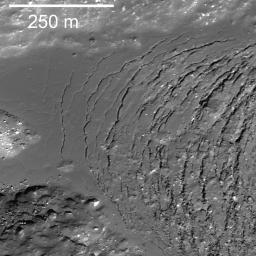More Impact Melt!
Caption:
Frozen impact melt flows on the floor of Moore F, a farside highlands crater. Image width 600 m, 0.61 m/pixel, NAC image M110383422LE.
The crater Moore F (about 23 km in diameter) exhibits a spectacular terraced rim and central uplift -- a beautiful example of a complex impact structure. Surrounding the central uplift, the crater floor is covered by both frozen impact melt flows and debris. The melt formed as a result of the tremendous energy released in the impact event. As the crater equilibrated, the melt flowed to low spots and slowly cooled. What caused the spectacular curved cracks to form?
Perhaps the crater floor topography changed over time, fracturing the surface of the central melt pond deposit (right side of picture) and opening a series of parallel, arcuate tension (pull-apart) cracks. Or, perhaps as the melt cooled and solidified, the volume change opened the cracks.
Background Info:
NASA's Goddard Space Flight Center built and manages the mission for the Exploration Systems Mission Directorate at NASA Headquarters in Washington. The Lunar Reconnaissance Orbiter Camera was designed to acquire data for landing site certification and to conduct polar illumination studies and global mapping. Operated by Arizona State University, the LROC facility is part of the School of Earth and Space Exploration (SESE). LROC consists of a pair of narrow-angle cameras (NAC) and a single wide-angle camera (WAC). The mission is expected to return over 70 terabytes of image data.
Cataloging Keywords:
| Name |
Value |
Additional Values |
| Target |
Moon |
|
| System |
Earth |
|
| Target Type |
Satellite |
|
| Mission |
Lunar Reconnaissance Orbiter (LRO) |
|
| Instrument Host |
Lunar Reconnaissance Orbiter |
|
| Host Type |
Orbiter |
|
| Instrument |
Lunar Reconnaissance Orbiter Camera (NAC) |
|
| Detector |
|
Narrow Angle Camera (NAC), Wide Angle Camera (WAC) |
| Extra Keywords |
Crater, Grayscale, Impact |
| Acquisition Date |
|
| Release Date |
2009-10-30 |
| Date in Caption |
|
|
| Image Credit |
NASA/GSFC/Arizona State University |
| Source |
photojournal.jpl.nasa.gov/catalog/PIA12921 |
| Identifier |
PIA12921 |

 Planetary Data System
Planetary Data System
